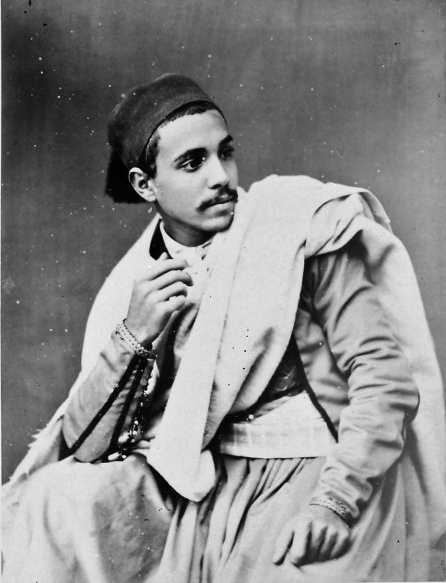Burnous on:
[Wikipedia]
[Google]
[Amazon]

 A burnous ( ber, ⴰⴱⵔⵏⵓⵙ ), also burnoose, bournous or barnous, is a long
A burnous ( ber, ⴰⴱⵔⵏⵓⵙ ), also burnoose, bournous or barnous, is a long

 A burnous ( ber, ⴰⴱⵔⵏⵓⵙ ), also burnoose, bournous or barnous, is a long
A burnous ( ber, ⴰⴱⵔⵏⵓⵙ ), also burnoose, bournous or barnous, is a long cloak
A cloak is a type of loose garment worn over clothing, mostly but not always as outerwear for outdoor wear, serving the same purpose as an overcoat, protecting the wearer from the weather. It may form part of a uniform. Cloaks have been and ...
of coarse wool
Wool is the textile fibre obtained from sheep and other mammals, especially goats, rabbits, and camelids. The term may also refer to inorganic materials, such as mineral wool and glass wool, that have properties similar to animal wool. ...
len fabric with a pointed hood, often white in colour, traditionally worn by Berber and other Maghrebi
Maghrebi Arabic (, Western Arabic; as opposed to Eastern or Mashriqi Arabic) is a vernacular Arabic dialect continuum spoken in the Maghreb region, in Morocco, Algeria, Tunisia, Libya, Western Sahara, and Mauritania. It includes Moroccan, Alge ...
men. In the Maghreb
The Maghreb (; ar, الْمَغْرِب, al-Maghrib, lit=the west), also known as the Arab Maghreb ( ar, المغرب العربي) and Northwest Africa, is the western part of North Africa and the Arab world. The region includes Algeria, ...
, the colour of the burnous may be white, beige, or dark brown. There are rock engravings near Sigus
Sigus is a town and commune in Oum El Bouaghi Province, Algeria
)
, image_map = Algeria (centered orthographic projection).svg
, map_caption =
, image_map2 =
, capital = Algiers
, coo ...
that attest the existence of the burnous in the ancient times, it was also worn by the Numidians
The Numidians were the Berber population of Numidia (Algeria and in smaller parts of Tunisia and Morocco). The Numidians were one of the earliest Berber tribes to trade with Carthaginian settlers. As Carthage grew, the relationship with the Nu ...
.
Historically, the white burnous was worn during important events by men of high positions. Today, men of different social standing may wear it for ceremonial occasions, such as weddings or on religious and national holidays.
Burnous in other cultures
The burnous became a distinctive part of the uniform of the French Army of Africa'sspahi
Spahis () were light-cavalry regiments of the French army recruited primarily from the indigenous populations of Algeria, Tunisia and Morocco. The modern French Army retains one regiment of Spahis as an armoured unit, with personnel now ...
cavalry, recruited in Algeria, Morocco, and Tunisia. It was also sometimes worn unofficially by officers or soldiers of other units in North Africa
North Africa, or Northern Africa is a region encompassing the northern portion of the African continent. There is no singularly accepted scope for the region, and it is sometimes defined as stretching from the Atlantic shores of Mauritania in ...
. The white burnous remains part of the parade uniform of the one remaining spahi regiment of the French Army: the 1st Spahi Regiment.
Other names for a burnous include ''albornoz'', ''sbernia'', ''sberna'', and ''bernusso''.
See also
* Birrus *Bernos {{short description, Cloak type
Bernos ( am, በርኖስ), also transliterated as Barnos and Burnos, is a wool cloak-like garment and hood woven in one piece, traditionally worn by men of the Amhara ethnic group of Ethiopia, most commonly in the r ...
*Kaftan
A kaftan or caftan (; fa, خفتان, ) is a variant of the robe or tunic. Originating in Asia, it has been worn by a number of cultures around the world for thousands of years. In Russian usage, ''kaftan'' instead refers to a style of men's ...
* Qashabiya
* Jelaba
*Qamis
Shalwar kameez (also salwar kameez and less commonly shalwar qameez) is a traditional combination dress worn by women, and in some regions by men, in South Asia, and Central Asia.
''Shalwars'' are trousers which are atypically wide at the wa ...
References
External links
* {{Authority control Moroccan clothing Algerian clothing Tunisian clothing Robes and cloaks